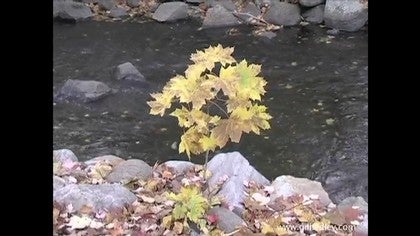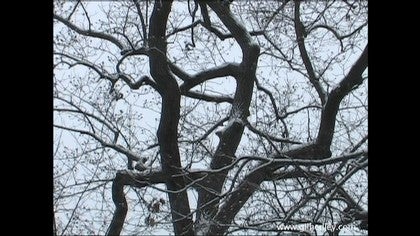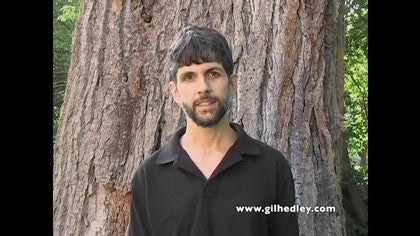Description
This video was filmed and produced by Gil Hedley. It includes videos and photos of dissections of cadavers (embalmed human donors). You can visit his website for more information about his workshops.
About This Video
Transcript
Read Full Transcript
[inaudible]
And we remember and acknowledge with gratitude those who have passed. We thank the families of the donors and we attend carefully to the gifts they have left us. Yup. Through the ever original combination of matter, motion, human intent and the intelligence of nature. New forms will be manifest to enrich our life experience as we pursue these ongoing experiments with balance relationships and a connection to the hidden layers of ourselves. The dissection progression represents a step-by-step movement into the deeper levels of the human form.
In this series we studied the body at the macro level. Here we intend to deep learning experience with the level of physical form which be readily observed with our eyes felt with our hands and differentiated with a fingertip or a scalpel and then reflected and removed for further appreciation and study the amazing worlds of micro biology. Molecular biology and physics remain outside the range of the camera lens is used on this particular project because patterns of relationship and structure have been proven to repeat at many different levels. Observations made at the gross level give us a very practical experience of the kinds of relationships which exist at other important levels of connection within us and between us applying the onion tree model to the whole body is a lens which focuses our attention, particularly on layered shifts of tissue textures and head to toe continuity's, which the human form presents. There are an infinite number of other ways.
One could choose to dissect a body and each one would reveal something new, something previously overlooked. I have experienced this layered approach to be a very powerful learning tool without needing for it to be the only word or the last word on the subject. There really are no layers in the integral human form that having been said, look at this amazing layer. When I speak of deep Fascia. In this presentation, I am referring very specifically to the mostly fibrous though sometimes filmy, sometimes translucent and often opaque and whitish layer that my hands and scalpel come up against just deep to the relatively soft and loose aerial or superficial Fascia and before coming to the red brown muscle fibers, the relationship of the deep Fascia to the superficial Fascia, it was explored in volume one trying to understand deep fascia without studying skin and superficial fashion is like trying to understand a marriage while ignoring the spouses. So here we are observing the very surface of the deep fascia in place as at first it presents to us before we the underlying relationship of the deep Fascia to the very different texture of the muscle.
Despite the stillness of the cadaver, the impression of fluid movements, patterns and energetic pathways are evident in the fashion. Every body is in some sense a physical hologram of interfacing wave forms of varying vibrations. Deep Fascia falls into the much broader category of connective tissue. All Fascia is connective tissue, but not all connective tissue is fashion. Connective tissue also includes blood and bone, the peri neural and peri vascular wrappings, and the entire omnipresent web that invests, surrounds, and interpenetrates every cell in stunning continuity right down into the cytoskeletal microtubules researcher James Ashman directs our attention to this spectacular whole body communication network, which the connective tissue matrix represents.
Robert Becker demonstrates it as a locus of healing and energetic phenomenon. Robert Schlep and his colleagues@fasciaresearch.com have definitively demonstrated the active contractility of the Fascia, which is in fact replete with specialized smooth muscle fibers, not merely the skeletal muscle, but the fashion itself. Also, actively contract Fascia is responsive and alive. I point out the anatomy of the Fascia at a gross physical level revealing its context and continuity across conventional regions. While skin covers the surface of the body, deep fascia covers the muscle layer, but it also spans the depth of muscle and relates through its many fibrous Septi right down to the bone. I habitually use the metaphor of a bag when I dissect deep fashion.
The deep Fascia is no more a bag than as a cell membrane. Since the idea of a bag may evoke a sheet like quality and deep fascists are related through countless vectors by fuzzy filmy, fibrous vascular neural and Perry neural trees. Just as cell membranes are interpenetrated by the flexible cytoskeleton linking with the extra cellular connected Tissue Matrix. Nevertheless, anatomy generates abstractions by the pound. My use of the bag metaphor for deep fascist speaks directly to the ease with which I can cut it up and make it appear as a sheet. I create the bags in order to define and clarify different tissue textures in the ultimate living human form.
Deep Fascia like all the other layers of the body is comprised of more than just fibers, cells and sundries. It has shot through with the pulsing vibratory phenomena of life itself. Precisely what is absent here from the cadaver form. When you take some time to internalize your experience of this program, be sure to notice and feel the joy of life expressed in the great gift of your human form.
So we have a bag that covers the whole body and then we have particular names for particular areas of the fashion. So a famous fascist, you could call them. This is a famous fashion, it's called the fashion Latin. So it's this fibers bag that develops the whole thigh, and of course it's in continuity rest the rest of the deep fashion of the body. So we'll focus in maybe around here and it'll allow the viewer to see some of the fin filmy tissue above the deep Fascia, which disguises its fibrous nature.
What we're looking at are remnants of the superficial fashion, but not merely remnants. We're looking at their relationship, the remaining relationship of the superficial fashion to the [inaudible]. Let's get even a little closer here. Let's see how close we can get to some of this tissue right here. And we'll see that there's something of a film here. We have this beautiful strong fibers here coming in this direction. And then on top of it is something of a film.
So if I can lift up this kind of filming tissue here and we can see, okay, when you see those beautiful pictures in the color atlas and they've gotten all of this film off, it's the most tedious process. It's fun, but it takes a lot of and patience. And while you're doing it, you often poke holes in the bag underneath and then it doesn't look as good for the picture. But I'm more concerned in this instance to demonstrate what it takes to get the picture and then you have a sense, a little more of the reality of the cadaver form and are our living tissues as well. So I back off a little bit this tissue and we can see, I can scrape a little bit with my scalpel, try and keep my shadow out of here and I'm lifting this film away and then we see more of that stripe quality, which underlies it. Now we have a form that's approximately six feet tall. The deep fascia covers the whole body. So rather than spending the next month, which I could easily do, perfecting this image, I'm trying to give you the concept of this beautiful stripe at ie strapping that constitutes the textures and depth of the bag of the deep Fascia as it overlays the musculature of the thigh.
So we have a beautiful multi-directional pattern here, right here. This little.here is a perforating vessel that's been severed. This would be blood flow to the superficial Fascia. The trees are perforating the bags. I think it would be most instructive to actually go inside the bag. Let's see if we can capture the whole fine here. At the same time, we can give a sense of what it will mean to enter this space. If I lift up right around here, over the knee, I can tug at the bag.
I can give it a little tug all along here and start to differentiate the the bag of the deep fascia from the tissue that's underneath it. So I differentiating at first that enables me to spare myself an untoward cut into the musculature so I can actually get my pinky under here a little bit. And start to get air if it's possible to see that air. Let's see. You can see the air sort of creeping in under the bag. Now I get my hemostat on her here and I can start a probe my way along this pathway. I'm neither poking into the muscles nor am I making holes in the deep fast shack place. Fine hemostat inside the bag.
It's pretty cool. So you've got a sense of the depth of the bag. It's transparent. I can see the silver or the hemostat through the bag. It's not thick bag and you have, it's the bag with tremendous integrity. Now relating the deep Fascia to the musculature itself, even in places where it's easy to slip and slide the deep fascia off, there's sort of fuzzy connected tissue relationships that that are more or less present in a given form.
Ultimately though, this is a fairly light relationship, the rectus, the Morris, which underlies the tissue here
Also some of the muscle fibers below as I yank on the deep Fascia. So you get a real sense here, I hope of the intimate relationship of the deep Fascia to the tissue beneath it. And then when I create a plane out of the deep Fascia, I'm doing so as an anatomist, as someone creating abstract realities from physical realities, because the tissue in fact is not a plane. It's multidimensional, multidirectional. Well, these are muscle fibers here. Yeah.
And this is the deep Fascia here. And this here is the relationship of the, of the, uh, FMI Cesium, the fashion around the muscle cells as they enter into a relationship with the deep fashion. So the deep fashion is a different texture altogether. And yet it's not like it's not connected. See, everything is connected.
But what happens is you get these transitional textures from one layer to the next. And that's what studying relationships is all about. And the sound sign, as I yank up on otherwise flat layer of that, the museum, you're able to see that its structure is very light and diaphanous and fluffy. Well lifting this bag, there's a blood vessel. Remember we saw a little something coming up through on this side.
Remember that tiny little walk. That's how we talk about, well, why don't we lift the bag when you look on the other side and we can see it in its length coming here,
Our body has no empty places in it, so if there's a kind of a wedge or something to be filled in and it'll be filled in with adipose tissue, a loose Ariel or adipose tissue. So I'm going to scratch my way along and see if I can get underneath this transition point where they tensor Fascia Lata is embedded in the fashion, a lot of itself in a deep Fascia and acting upon it. I can actually take my finger, trace it through this fuzz and the first just mounts to my finger. It's not tough at all. Reflecting that the deep Fascia, we see it from a different perspective and it's possible to serve peak in at what I'm looking at on this side of the table here and if I press here and slide with my fingertip, I can kind of clean the tissue off. Yeah. Since free.
The tissues that have always been intimately bound. Now ultimately you would think at this rate I could be able to go around the whole form from one side of the thigh to the other and back around, but in fact what's going to happen is we come to the end, it's a compartment, there's a stopping point where the tissue of the deep fashion dives under to the bone. It's on the surface. And then on inner portion of it dies under to the bone and connects to the bone creating a compartment for this musculature relative to the musculature of the hamstrings or in the front over here, we'll run into a, let's call the septum where the hand can slide no more in the bag because the bag itself sends down scrolls it's way down, creating a particular compartment for these, uh, muscle tissues here, uh, relative to other muscle tissues. See that grid? It's incredible. So the,
[inaudible] Lotta Dark Mary's friends, et Cetera. I can see that. [inaudible]
It's just a bit more fibrous here. So these photographs in the atlases and the drawings by the artists representing the retina vaccuum if you want to create that sort of thing, you just, well yeah, cut here and you could do the same up above. You Really wanna make a right Nacchio one famous one. Let's do it. Let's create the extensor retinaculum. See I pulled back the deep Fascia, slice it away from its relationship.
Here I create a border, and if I just kept peeling all this away
And so we ended up with the striped look because at these points along these lines in between these muscle fibers we have arising up connective tissue that's rising up to meet the deep Fascia that I'm peeling back. So it's not as if this deep fascia that I'm this, this plane of tissue here has any substantive reality other than as an abstraction from the cutting of my knife, I pulled back on the tissue and my scalpel goes dull, severing the deep fibrous connection from the covering, from the fibers covering. So the covering is only a covering to the extent that I cut it away from its third dimensional roots. There are no independent structures in the human form, the human form. It may even be a mistake to consider the human form itself as an independent structure because it's embedded in its environment in ways that we cannot necessarily perceive with our eyes.
And yet there are relationships, vibrational relationships between everything in a given environment. And those relations strike me as no less or more significant than these physical connections that I'm demonstrating fear as I peel back a deep fashion with knife, scalpel and Hemostat, where does one tissue and in another begin? Well, pretty much wherever we decide, because to the extent that we create the division or identify one thing from another in the human form, we are basically writing a mythology or creating a model that at some point must be dumped for on deeper understanding. If we claim to a model that may have worked for a while, it's like refusing to go further in their learning process. I speak of several layers of the form as a way of augmenting regional anatomical model and creating yet another way of looking at the body. However, it's also true that my model here of the layered form or the onion tree with layers and interstitial with tree-like structures, the vasculature of the nerves will also develop and become more sophisticated.
Uh, we mustn't cling to them, our models too tightly.





You need to be a subscriber to post a comment.
Please Log In or Create an Account to start your free trial.